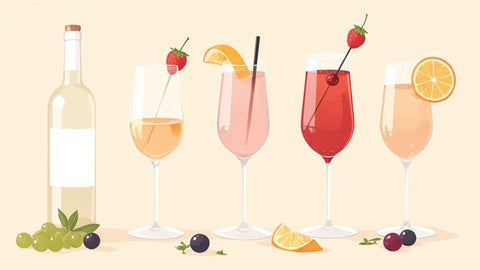Introduction
McLaren Vale is celebrated for powerful yet elegant reds, sun-drenched vineyards and a strong ethic of stewardship. This expanded guide explores sustainable Shiraz, Grenache and blends that reward patience in the cellar and create memorable moments when shared. Detailed guidance covers terroir, viticulture, winemaking choices that influence ageing, practical cellaring methods, pairing menus and hosting ideas to build a purposeful, pleasure-driven cellar.
McLaren Vale at a Glance
- Climate: Mediterranean with warm, dry summers tempered by maritime influence from the Gulf St Vincent. Diurnal temperature variation moderates ripening and preserves acidity.
- Soils: A patchwork of sand, loam, ironstone, terra rossa and deep clay pockets. Soil diversity creates distinct flavour profiles across neighbouring sites.
- Vine age: A significant portion of older vines (some planted a century ago) contributes concentration, depth and complexity to Shiraz and Grenache bottlings.
- Regional character: Wines often combine ripe fruit intensity with savoury, earthy undertones and lifted aromatics — a versatile foundation for both early drinking and long-term cellaring.
Sustainability and Stewardship: Practical Measures That Matter
Sustainability covers water use, soil health, biodiversity, energy use and chemical inputs. Look for explicit practices rather than vague claims; indicators of meaningful stewardship include:
- Organic or biodynamic certification where applicable (e.g. Australian Certified Organic, Demeter)
- Participation in recognised sustainability programs and clear public reporting on targets
- Dry-grown or reduced-irrigation blocks, promoting deeper root systems and richer fruit concentration
- Cover cropping, composting and integrated pest management to support soil life and reduce synthetic inputs
- Water-efficient irrigation systems and on-site rainwater capture
- Energy-saving cellar technologies, reduced packaging weight and recycling initiatives
How Terroir Shapes Shiraz and Grenache
Terroir in McLaren Vale is a mosaic. Key influences:
- Shallow, well-drained sands and ironstone often produce wines with fragrant lift and supple tannins.
- Deeper clay soils can yield denser, more structured wines with extended ageing potential.
- Coastal sites receive cooling breezes that preserve natural acidity and aromatic clarity in Grenache and Shiraz.
- Aspect and slope affect ripeness — north-facing slopes deliver riper phenolics; cooler aspects preserve tension.
Shiraz: Styles, Flavour Profiles and Ageing Trajectories
Shiraz from the Vale ranges broadly. Understanding styles helps build a balanced cellar:
- Fruit-driven Shiraz: Bright dark-berry and chocolate notes, softer tannins. Best enjoyed across 2–8 years.
- Regional, savory Shiraz: Black pepper, leather, olive and ironstone minerality with steady acid structure. Cellaring window commonly 7–15 years.
- Old-vine and single-site Shiraz: Concentrated layers of black fruit, earth, spice and fine-grained tannins. These can evolve for 15–30+ years when stored correctly.
Tasting cues for cellaring potential: pronounced but fine-grained tannin, balanced acidity, layered aromatics and a firm mid-palate suggest longevity rather than immediacy.
Grenache: Versatility, Elegance and Age-Worthiness
Grenache shows remarkable range in McLaren Vale. Broad categories include:
- Lifted, light-to-medium Grenache: Strawberry, raspberry, white pepper and florals. Friendly and sociable; drinks well young and gains complexity over 3–8 years.
- Fuller Grenache: Deeper red-fruit, savoury spice and polished tannins. These benefit from 6–12 years in bottle and often show gorgeous tertiary notes with more time.
- Grenache-dominant blends: Combined with Shiraz and other Mediterranean varieties, yielding structure and depth ideal for medium to long-term cellaring.
Blends and Alternative Varieties: Enhancing Structure and Complexity
Blends are a hallmark of the region. Common partners and their roles:
- Shiraz-Grenache blends: Shiraz adds depth and spice; Grenache contributes brightness and charm.
- Incorporation of Mourvèdre, Tempranillo or Cabernet elements: These add tannic backbone and savoury complexity, extending cellaring life.
- Alternative varieties such as Sangiovese or Nero d'Avola: Provide acidity lift and unique savoury profiles that complement McLaren Vale reds.
Viticulture Practices That Improve Ageing Potential
- Dry-grown vines or deficit irrigation: Concentrates fruit and builds phenolic intensity suited to long-term ageing.
- Old-vine blocks: Lower yields and complex root systems impart depth and naturally balanced tannins.
- Canopy management: Aimed at even ripening and retention of natural acidity, essential for wines that will age.
- Deliberate harvest timing: Picking for phenolic ripeness rather than maximum sugar leads to better balance in the bottle.
Winemaking Choices That Influence Cellaring
Winemaking drives how a wine develops in bottle. Key choices include:
- Extraction and fermentation regime: Gentle extraction preserves fine tannin; extended maceration can build structure for ageing.
- Use and treatment of oak: French or American oak, barrique vs larger format, new vs seasoned — all shape tannin texture and tertiary development.
- Whole-bunch fermentation and carbonic elements: Can add lift and spice, altering how flavours evolve in bottle.
- Reduced intervention approaches: Minimal filtration and judicious sulphur use can produce vibrant, terroir-driven wines with distinct ageing paths.
Cellaring Science: What Makes a Wine Age Well?
Ageing potential depends on balance. The basic pillars are:
- Acidity: Preserves freshness over time and supports flavour evolution.
- Tannin: Acts as a preservative and contributes structure; its texture determines long-term drinkability.
- Alcohol: High alcohol can be warming and affect balance; well-integrated alcohol is less obtrusive in age-worthy wines.
- Fruit concentration and phenolic complexity: Provide the raw material for development into tertiary notes such as leather, earth, dried fruit and spice.
Practical Cellaring Essentials
- Temperature: Aim for 12–14°C for long-term storage. Stability is as important as the exact temperature.
- Humidity: 60–70% prevents corks from drying while avoiding mould.
- Light: Avoid direct sunlight and fluorescent lighting to protect colour and aromas.
- Vibration: Minimise movement; constant vibration accelerates undesirable reactions.
- Positioning: Store cork-sealed bottles horizontally and screw-capped bottles upright, according to manufacturer guidance.
- Inventory management: Log purchase dates, vintage and ideal drinking windows. Rotate stock on a first-in, first-out basis for short to medium-term bottles.
Closures and Their Impact on Ageing
Closure choice affects oxygen ingress and ageing trajectory:
- Cork: Traditional, variable oxygen transmission that can develop tertiary complexity. Good-quality natural cork remains a valid choice for long-term cellaring.
- Synthetic cork: Consistent but generally less suitable for very long-term ageing.
- Screw-cap: Provides highly consistent low oxygen transmission. Many premium screw-cap wines have proven excellent ageing stability; check producer guidance for long-term intent.
Building a Cellar Strategy
Consider a balanced approach to cover everyday drinking, medium-term ageing and long-term investments:
- Allocation: Reserve roughly 60% for approachable, shareable bottles, 30% for medium-term keepers and 10% for long-term special bottles.
- Budget tiers: Mix entry-level, mid-range and premium bottles rather than concentrating spend on a single band.
- Vintage diversity: Buy across vintages to smooth year-to-year variation and provide options for immediate drinking versus cellaring.
- Mixed packs: Curated mixed cases combining Shiraz, Grenache and blends are an efficient way to cover multiple drinking windows.
Buying and Provenance: How to Choose with Confidence
- Read technical notes that detail vineyard practices and maturation — these often reveal whether a wine is intended for ageing.
- Purchase from reputable retailers or direct from regional cellars with clear storage and provenance policies.
- Check for sustainability information on labels or websites: look for specific practices, certification and transparent reporting.
- Consider buying small allocations of premium bottles rather than large volumes of single labels to diversify risk and tasting experiences.
Storage Solutions: From Fridge to Professional Facilities
- Wine fridges: Good for short to medium-term storage; choose units with temperature stability and low vibration.
- Dedicated cellar rooms: Offer the best long-term environment when temperature and humidity are controllable.
- Professional bond stores: Ideal for valuable bottles; they maintain provenance and insurance during storage.
Serving, Decanting and Glassware
Proper service elevates wines and reveals their age or youthful energy:
- Glassware: Use tulip-shaped red wine glasses to concentrate aromas and allow palate expression.
- Serving temperature: Lighter Grenache 14–16°C; fuller Grenache and most Shiraz 16–18°C; older, delicate reds slightly cooler within those ranges.
- Decanting: Young, tannic Shiraz benefits from 30–90 minutes of decanting. Mature bottles may require careful, brief decanting to separate sediment and awaken aromas.
- Breathing tips: For wine with significant tertiary development, pour gently and allow short exposure rather than aggressive aeration.
Food Pairing Menus: Courses to Showcase McLaren Vale Reds
Design menus that match intensity and flavour profile with the wine’s structure:
- Casual sharing: Grilled lamb skewers, smoky eggplant dips, marinated olives and aged cheddar with mid-weight Shiraz or Grenache.
- Three-course menu: Starter of charred beets and goat curd with light Grenache; main of slow-roast shoulder with structured Shiraz; dessert of dark chocolate tart with a richer late-picked Grenache or fortified-style wine.
- Vegetarian feast: Tomato and rosemary tart, mushroom ragu and roasted root vegetables with Grenache blends that bring acidity and spice.
Hosting a McLaren Vale Tasting: Structure and Tips
- Choose a theme: single variety across vintages, Shiraz vs Grenache, or sustainable producers only.
- Flight size: 3–6 wines per flight avoids palate fatigue and keeps conversation focused.
- Palate cleansers: Plain water, neutral crackers and mild cheeses help reset between flights.
- Tasting order: Lighter and younger to fuller and older; finish with the richest wines or blends.
- Note-taking: Encourage short tasting notes on aromas, palate, structure and potential drinking window to compare impressions later.
Blind Tasting Tips to Appreciate Ageing and Terroir
- Cover labels and assess colour, rim variation and clarity to infer age and variety.
- Smell for primary fruit, oak influence and tertiary notes such as leather, earth or dried herbs.
- On the palate, evaluate acidity, tannin grain, alcohol warmth and finish length to judge ageing potential.
Sustainability-First Shopping: Practical Signals
- Clear certification logos and links to farm-level practice pages.
- Transparent descriptions of vineyard inputs (compost use, reduced sprays, cover crops).
- Packaging choices: lighter bottles, recycled cartons and minimal plastic indicate lower environmental footprint.
- Energy disclosures and waste reduction initiatives from the cellar indicate long-term stewardship.
Budget-Friendly Strategies for a High-Quality Cellar
- Focus on lesser-known single-site names or regional blends for better value.
- Buy mixed cases or cellar packs from specialist retailers to access discount pricing without compromising quality.
- Buy by the case of easy-drinking Shiraz or Grenache to supply regular gatherings and decant a few bottles for special occasions.
Selection Checklist: Choosing Bottles That Deliver
- Identify the intended drinking window: immediate, short-term (3–8 years), medium-term (8–15 years) or long-term (15+ years).
- Check technical notes for pH, alcohol and maturation details — these reveal balance and ageing intent.
- Look for clear statements about vineyard practices and sustainability if that is a core value for the cellar.
- Balance the cellar with a mix of approachable and age-worthy bottles to ensure both sharing and future rewards.
Final Thoughts: Curate with Purpose and Share with Joy
Building a McLaren Vale cellar that prioritises sustainability, authenticity and great drinking is a rewarding endeavour. Focus on balanced wines that reflect terroir, seek out clear evidence of stewardship in vineyard and cellar, and construct a cellar strategy that accommodates immediate conviviality and long-term enjoyment. These wines are made to be shared — a carefully chosen bottle can deepen connection around the table and honour the land that produced it.
Next Steps
- Start a cellar log today: note purchase date, vintage, tasting impressions and intended drinking window.
- Select one Shiraz, one Grenache and one blend with clear sustainable credentials as a starter trio.
- Plan a seasonal tasting with friends or a small group to explore how McLaren Vale reds evolve across vintages and styles.
With these guidelines, the cellar will become a living collection that celebrates McLaren Vale’s diversity — sustainable, considered and meant for sharing.




Comments (0)
There are no comments for this article. Be the first one to leave a message!